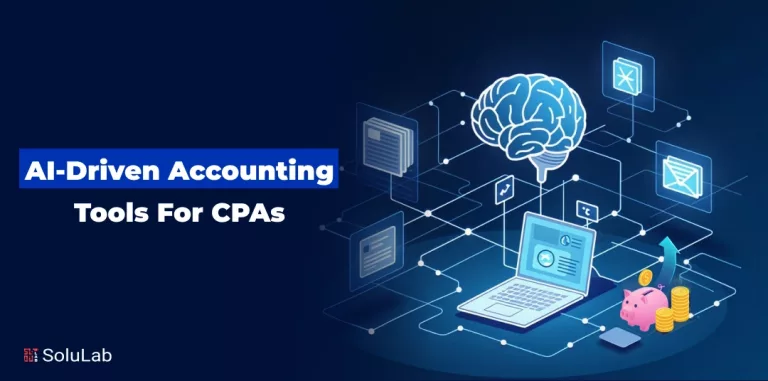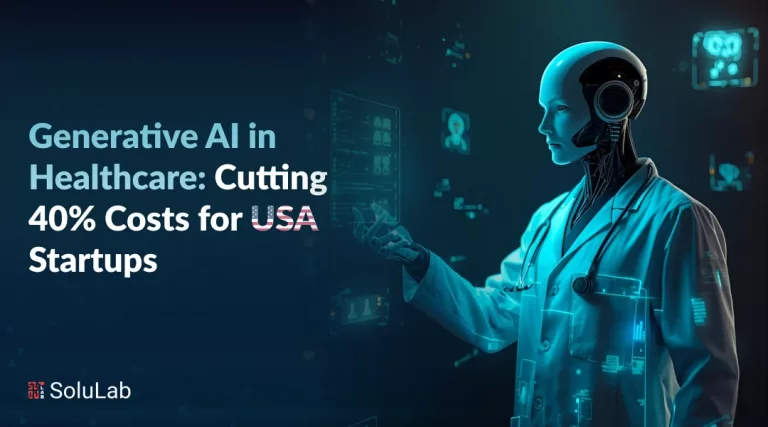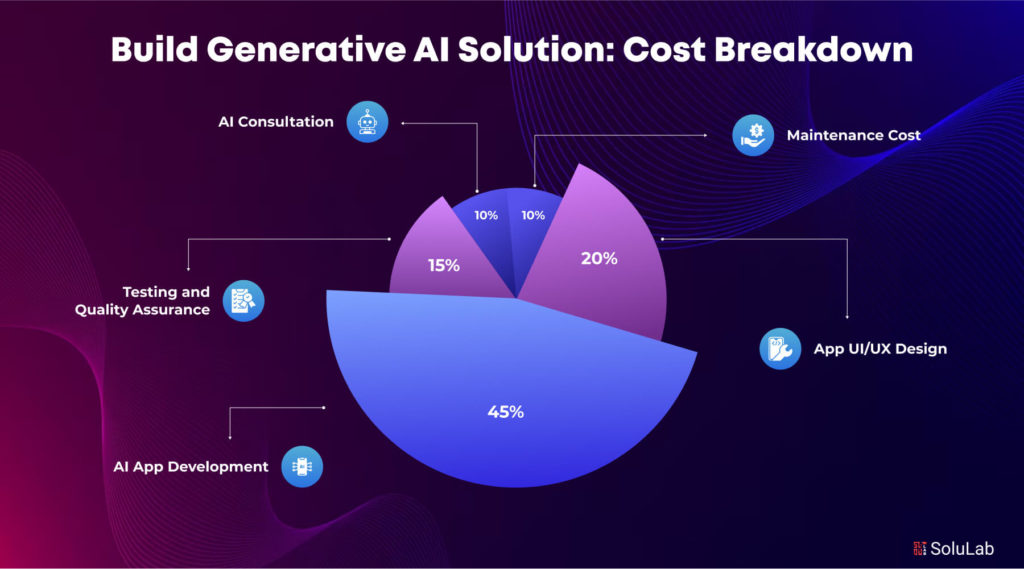
Thinking of building your own generative AI solution in 2025? You’re not alone!
With tools like ChatGPT, Midjourney, and custom AI copilots making headlines, businesses across industries are racing to explore what generative AI can do for them.
But then the big question comes up: “How much is this going to cost?” accompanied with a few more- Is it a six-figure investment only tech giants can afford? Or can startups and mid-sized businesses also tap into the power of generative AI without draining their budget?
In this blog, we’ll walk you through everything you need to know, from development and infrastructure costs to team size, APIs, and more. Whether you’re budgeting for an AI-powered chatbot, a content generator, or a full-scale enterprise solution, we’ll help you understand where your money goes.
Let’s get started!
Types of Generative AI Models
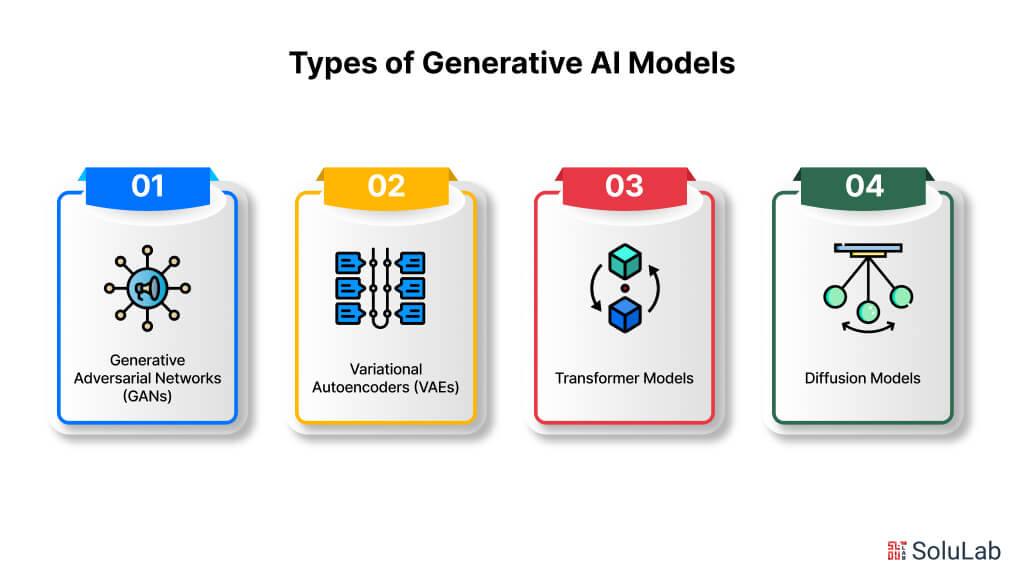
There are several varieties of generative AI models, each with unique structures and uses. Here’s an overview of the key types:
1. Generative Adversarial Networks (GANs)
GANs are among the most prevalent types of generative AI models. They consist of two neural networks: the generator and the discriminator, which operate in opposition to one another. The generator is responsible for creating new data, while the discriminator evaluates the authenticity of this generated data by determining whether it resembles real data. Through this competitive process, the generator becomes increasingly proficient at producing realistic data. GANs are widely used in applications like video synthesis, image creation, and even the development of deepfakes.
2. Variational Autoencoders (VAEs)
VAEs are probabilistic models that encode input data into a latent space and then decode it to produce new data. They feature two neural networks: an encoder and a decoder. Unlike GANs, VAEs focus on learning the distribution of input data, enabling them to generate new samples by drawing from this distribution. VAEs are commonly used in fields requiring diverse and high-quality data, such as drug discovery and design.
3. Transformer Models
Transformers, such as GPT, represent a neural network architecture that has significantly influenced the field of natural language processing (NLP). These models use self-attention mechanisms to process and generate text sequences. Transformers are instrumental in creating advanced language models capable of generating human-like text, answering questions, and translating languages. They are integral to many generative AI applications and solutions.
4. Diffusion Models
Also known as denoising diffusion probabilistic models (DDPMs), diffusion models are generative models that map vectors in latent space using a two-step process during training. The first step, known as forward diffusion, involves gradually adding random noise to the training data. The second step, reverse diffusion, removes the noise to reconstruct data samples. By running reverse denoising starting from pure random noise, these models can generate entirely new data. Diffusion models play a crucial role in the development of innovative generative AI and automation solutions.
These diverse types of generative models are foundational to the development of Gen AI apps, driving innovation across various industries by automating content creation and enabling sophisticated data generation.
How Does Generative AI Work?
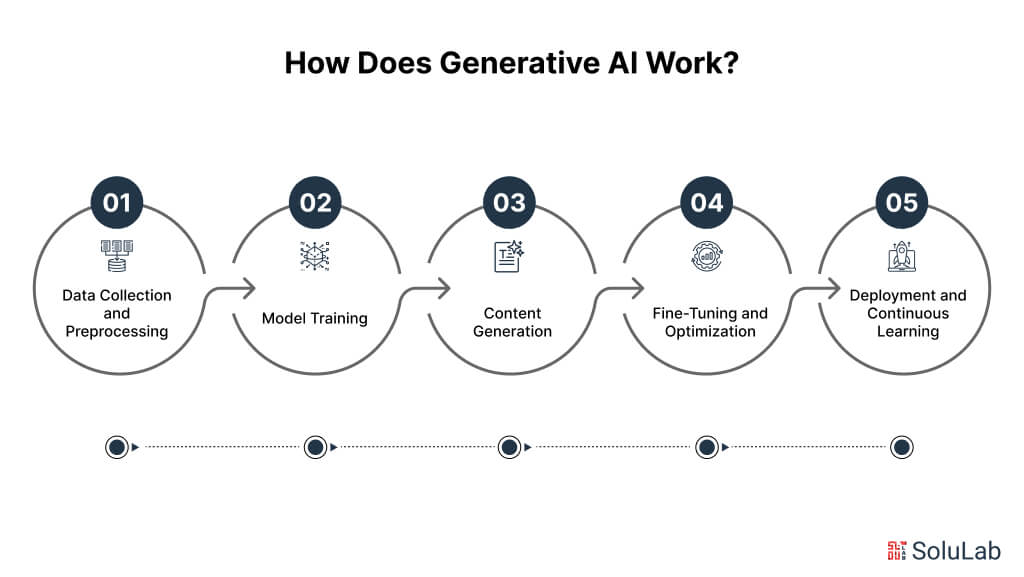
Generative AI uses advanced machine learning models to create new content, such as text, images, or even music, that mimics human creativity. The process typically involves training a model on a large dataset, enabling it to recognize patterns, relationships, and structures within the data. Here’s a breakdown of how Generative AI works:
1. Data Collection and Preprocessing
Generative AI starts with collecting vast amounts of data relevant to the task at hand. This data may consist of audio, video, text, or photos. The data is then preprocessed to ensure it’s clean, structured, and ready for training. For enterprises, this step is crucial as the quality of data directly impacts the accuracy of the AI models.
2. Model Training
During this phase, the AI model is trained using algorithms like Generative Adversarial Networks (GANs) or Variational Autoencoders (VAEs). The model learns from the data by identifying patterns and structures, gradually improving its ability to generate new content. Leading generative AI development companies in 2025 are utilizing these sophisticated models to push the boundaries of AI capabilities.
3. Content Generation
Once trained, the model can generate new content that is strikingly similar to the original data. The AI can create meaningful phrases, paragraphs, and even full articles, for instance, when it comes to text production. In image generation, the AI can create realistic pictures from scratch. Generative AI for enterprises is particularly valuable in automating content creation, enhancing creativity, and driving innovation.
4. Fine-tuning and Optimization
After the initial content generation, the model may require fine-tuning to meet specific requirements. This step involves adjusting the model to produce more accurate or contextually relevant content. Enterprises often work with Generative AI Development Companies to customize AI solutions that align with their unique business needs.
5. Deployment and Continuous Learning
Finally, generative AI models are deployed within the enterprise environment, where it can continue learning and improving over time. Continuous learning is essential as it allows the model to adapt to new data, trends, and user preferences, ensuring that the generated content remains relevant and valuable.
By understanding how Generative AI works, enterprises can unlock new possibilities in content creation, innovation, and automation, positioning themselves at the forefront of technology in 2025.
Key Components of Building a Generative AI

Creating a Generative AI system involves several essential components, each adding to the project’s cost and complexity. Here’s a breakdown of these elements:
1. Data Collection
To build a generative AI, you need to gather and process extensive datasets. The accuracy and performance of your model heavily depend on the quality and diversity of this data.
Acquiring high-quality data can be costly, especially if you’re purchasing datasets from third-party providers or conducting extensive research to secure proprietary data. Alternatively, you could use publicly available datasets, but these often require significant cleaning and preprocessing, which adds to the cost. Depending on the industry, data acquisition expenses can range from thousands to millions of dollars.
High-quality data should accurately represent the relevant domain to ensure the generation of realistic and pertinent outputs. Raw data must undergo cleaning, annotation, and preprocessing to remove noise, biases, and inconsistencies. You’ll need domain experts and skilled data engineers for tasks like data labeling, augmentation, and normalization, which add to the overall cost. Poor-quality data may lead to inaccurate models, necessitating more iterations and corrections, which are both time-consuming and costly.
2. Model Development
At this stage, you can either develop a new model from the ground up or modify an existing one. Each approach comes with its own costs and challenges. Creating an AI model in-house from scratch involves significant investment in research and development, with a need to experiment with different architectures, algorithms, and hyperparameters. This process is resource-intensive, particularly for complex models like transformers or GANs, often requiring Parameter-Efficient Fine-Tuning (PEFT) for optimization.
Alternatively, you can use an open-source model or license a pre-built one, which can reduce initial development costs. While open-source models may lower costs upfront, they come with expenses related to integration, customization, and ongoing support. Proprietary models, though often more powerful and tailored for specific tasks, can be expensive in terms of licensing fees. The costs vary depending on the industry, scope, and scale of the project.
Hiring top-tier talent such as machine learning engineers, data scientists, and domain experts is another significant expense. These professionals command high salaries due to the complexity of their roles. Costs associated with recruitment, training, and retention can amount to hundreds of thousands of dollars annually.
3. Computational Resources
To develop and train generative AI models, substantial computational power is required. You’ll need to invest in high-performance hardware, particularly Graphics Processing Units (GPUs) and Tensor Processing Units (TPUs), which are specialized processors designed for large-scale parallel computations essential in deep learning tasks. The cost of GPUs or TPUs is substantial, and you’ll also need servers, storage, and cooling systems to ensure smooth operation.
An alternative to physical hardware is utilizing cloud computing services. You can rent scalable computing power from providers like Amazon Web Services (AWS), Google Cloud, or Microsoft Azure. While this approach reduces upfront capital expenses, the costs can escalate during the intensive training phases of model development. The overall cost will depend on the number of processing hours, data storage needs, and the types of instances used.
4. Software and Tools
Developing a generative AI model requires several software tools and frameworks, each contributing to the project’s overall cost. Acquiring machine learning frameworks and libraries such as PyTorch, TensorFlow, and Keras incurs additional expenses. These tools provide the necessary building blocks for designing, training, and deploying AI models. Although many of these frameworks are open-source and free to use, implementing them often involves hidden costs, such as the need for specialized expertise and integration with other platforms.
Companies will also face costs related to data preprocessing, model validation, and deployment. Some may need to pay licensing fees or subscription costs for certain tools or services, contributing to the overall generative AI pricing.
In addition to data and computational resources, developing Generative AI models also requires a variety of software tools and frameworks, each playing a role in the overall cost and complexity of the project. Whether you’re an AI gen app builder or exploring generative AI solutions, understanding these components is crucial to managing costs effectively.
Read Also: AI Integration Cost For Your Business
Cost of Developing a Generative AI Application
Creating generative AI applications comes with a wide range of costs. For basic generative AI apps, expenses typically range between $20,000 to $150,000, while more advanced applications can cost between $100,000 and $500,000. These figures are approximations, and actual costs may vary based on features and complexity.
Factors Influencing the Cost of Developing Generative AI
Several factors impact the cost of building generative AI applications. Technical experts and businesses need to be aware of these elements.
1. Scope and Complexity
The generative AI development cost depends significantly on the application’s scope and complexity. More sophisticated applications, with advanced features like detailed image creation or nuanced language understanding, demand greater development effort and research, leading to higher costs. Simpler text generation apps tend to be less expensive.
2. Type of Generated Content
The type of content your application generates—whether it’s text, audio, images, or a combination—also influences the cost and complexity of development. For instance, video or image generation requires more advanced algorithms and models compared to text-based apps, resulting in higher costs.
3. Research and Development (R&D)
Investing in research is crucial for building a robust generative AI app. You’ll need substantial resources to hire talented researchers, data experts, and other specialists. To create a more innovative and original generative AI, a significant investment in advanced R&D is necessary. Skilled researchers and data scientists may earn between $50,000 and $150,000, while domain experts could earn between $60,000 and $120,000.
4. Algorithm and Model Selection
Choosing advanced or custom-trained models with superior algorithms increases development costs. Implementing sophisticated algorithms can cost between $40,000 and $120,000. Opting for a custom or tailored model structure may incur costs ranging from $50,000 to $150,000.
5. User Interface (UI) and User Experience (UX)
A well-designed UI/UX enhances the overall user experience. Developing a user-friendly interface requires additional design and development efforts, thereby increasing the overall budget.
6. Data Acquisition and Processing
High-quality datasets are essential for effectively training generative AI models. The process of acquiring, cleaning, and processing these datasets adds to the costs, particularly for extensive or specialized data. Acquiring premium datasets can range from $30,000 to $100,000, while data cleaning and processing may cost between $20,000 and $60,000.
7. Integration with External Systems
If the generative AI app needs to integrate with external systems, APIs, or databases, the complexity and cost of development increase. Integration costs can range between $30,000 and $100,000, with deployment costs varying from $40,000 to $120,000.
8. Testing, Validation, and Quality Assurance
Ensuring your app’s reliability and effectiveness requires rigorous testing and validation, including functional testing, user testing, scenario testing, and performance testing. Comprehensive testing helps identify and fix issues early but increases costs. Testing procedures can range from $20,000 to $60,000, with validation costs between $30,000 and $80,000.
9. Development Team Skill Level and Expertise
The expertise and skill level of your development team—comprising engineers, data scientists, and researchers—affect both development time and costs. Highly skilled teams produce high-quality applications and command higher salaries, which increases project expenses. Compensation for skilled professionals may range from $80,000 to $150,000.
10. Maintenance and Updates
Ongoing maintenance, updates, and improvements are necessary to keep the generative AI app efficient and relevant, contributing to long-term costs. Maintenance can cost between $40,000 and $100,000, with associated improvements potentially costing between $50,000 and $150,000.
11. Geographic Location of Your Development Team
The location of your development team significantly impacts costs. Teams based in Western Europe and North America typically command higher rates than those in Africa, South America, Asia, or Eastern Europe. If you’re looking to develop an application cost-effectively, consider partnering with a generative AI development company in a more affordable region.
12. Data Training
The process of acquiring, cleaning, and annotating large volumes of high-quality data is labor-intensive. You may need to invest in human annotators, data collection tools, or third-party data providers, which can increase costs.
13. Infrastructure Costs
Developing and running advanced AI models requires robust computational infrastructure. Costs can include acquiring high-performance TPUs or GPUs, as well as scalable cloud computing resources. While cloud services offer more flexibility, they may accrue higher operational costs over time. Maintenance, data storage, and bandwidth also contribute to the infrastructure costs of deploying AI applications. Specialized processors and GPUs can cost between $40,000 and $120,000, while cloud services might range from $30,000 to $80,000.
14. Regulatory Compliance and Ethical Considerations
Addressing security concerns, mitigating biases in the app’s outputs, and ensuring compliance with data privacy regulations like GDPR require specialized resources and expertise. These measures help avoid operational disruptions, reputational damage, and legal penalties but come with additional costs. Adhering to data protection and privacy laws may cost between $30,000 and $80,000, with audits potentially costing between $40,000 and $100,000.
The total cost of deploying a generative AI app can range between $600,000 and $1,500,000, depending on these various factors. When considering generative AI development, it’s crucial to understand these costs and plan accordingly to build effective and efficient gen AI tools.
Read Also: How Much Does It Cost to Build an AI App in 2025?
Cost Estimation Example
To give a rough estimate, the cost to build a basic generative AI application with minimal features typically ranges between $40,000 and $100,000. However, if you’re looking for a more feature-rich application that incorporates advanced technologies, extensive features, and a high-quality design, the cost of generative AI development can increase significantly, ranging from $100,000 to $400,000 or more.
AI Development Phases and Cost Breakdown
Here’s a breakdown of the generative AI costs across different development phases:
| AI Development Phase | Cost Breakdown |
| AI Consultation | 10% |
| App UI/UX Design | 20% |
| AI App Development | 45% |
| Testing and Quality Assurance | 15% |
| Maintenance Cost | 10% |
Conclusion
Building a generative AI solution is a complex and costly endeavor that requires significant investment in research, development, and infrastructure. As we’ve outlined in this post, the costs of building a generative AI solution can range from tens of thousands to millions of dollars, depending on the scope and complexity of the project.
However, despite these challenges, building a generative AI solution can be a game-changer for businesses looking to stay ahead of the curve. But how do you overcome these challenges? At SoluLab, as a top Generative AI development company, we have the expertise to help you navigate the complexities of building a custom solution. Our team of experienced engineers can work with you to design and develop a tailored solution, just like we did for Aman Bank by integrating generative AI solutions.
If you’re interested in learning more about how we can help, get in touch with us. We’d be happy to discuss your project and provide a customized quote!
FAQs
1. What are the main cost factors involved in building a Generative AI solution?
The primary cost factors include data acquisition and processing, model development and training, cloud infrastructure, skilled talent acquisition, and ongoing maintenance. The total cost may also be affected by customization, integration with current systems, and regulatory compliance.
2. How does the complexity of the Generative AI model affect the cost?
The complexity of the model directly impacts the cost. More sophisticated models require extensive data, advanced algorithms, and longer training periods, which can increase both development time and computational costs. Customization and fine-tuning for specific use cases also contribute to higher expenses.
3. Can pre-trained models reduce the cost of developing a Generative AI solution?
Yes, using pre-trained models can significantly reduce development costs. Pre-trained models provide a strong foundation, allowing businesses to save time and resources by leveraging existing AI frameworks. However, customization and fine-tuning may still be necessary, which could incur additional costs.
4. What role does cloud infrastructure play in the cost of a Generative AI solution?
Cloud infrastructure is a crucial component, as it provides the necessary computational power for training and deploying AI models. The scale of operations, volume of data handled, and degree of computational resources needed all affect how much cloud services cost. Optimizing cloud usage is essential to manage costs effectively.
5. How much should businesses budget for ongoing maintenance and updates?
Ongoing maintenance and updates are vital for ensuring the long-term success of a Generative AI solution. Businesses should budget for regular model updates, performance monitoring, security patches, and potential scaling needs. These costs can vary depending on the complexity of the solution and the frequency of updates, but it’s recommended to allocate 15-20% of the initial development cost annually for maintenance.




